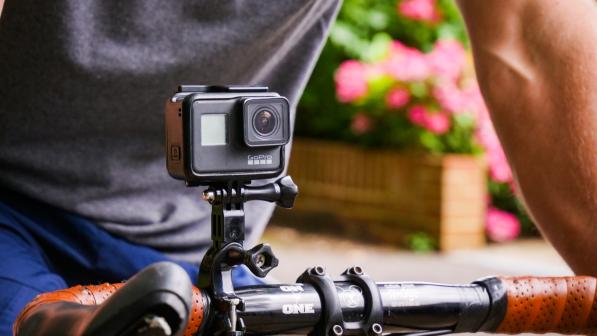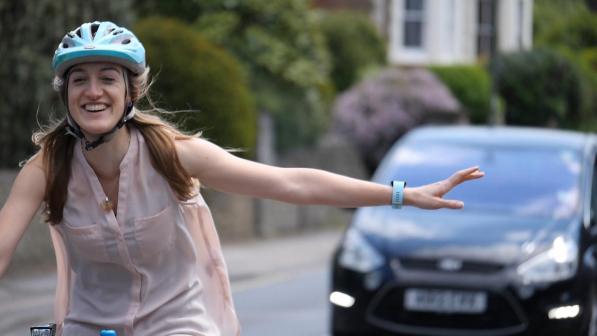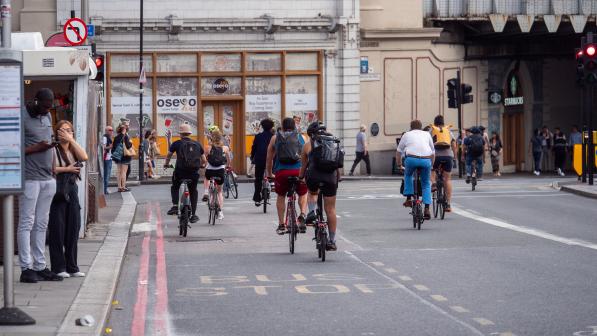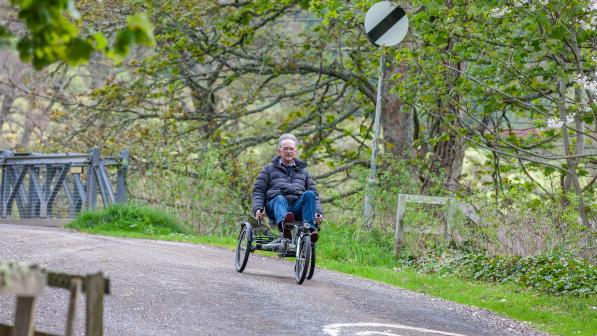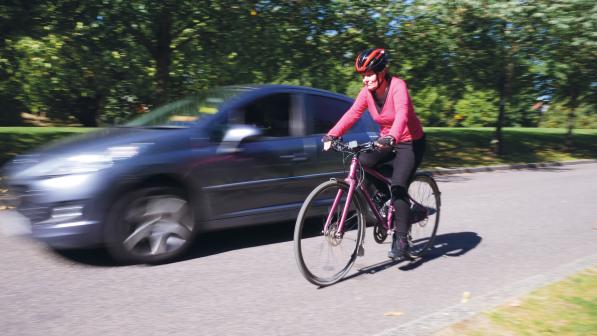Abuse on the roads disproportionately deters women from cycling

When I realised a few months ago that my colleague Emma lives only a few doors down the same street as me, I suggested we cycle together. Although she was enthusiastic, she was in need of a confidence boost, so I took her out on a few short rides just the two of us – some all-road rides, some a mixture of road and off-road (and, of course, all involving coffee and cake).
Commuting to work
There’s no direct route to Cycling UK’s office by train and the bus service is not the best where we live. Additionally, with the current cost-of-living crisis, like most people in the UK I want to keep my outgoings as low as possible, and I hate using the car unnecessarily. So I cycle, because it’s free – among many other benefits.
When our first ride to work came – just 4.6 miles – we were close passed. I reported this to the police and got on with my day. The second time we rode into work was much the same: close passes on the same stretch of road.
This stretch is a winding A-road spanning 1.6 miles and has a speed limit of 40mph; it has no safe places to pull in to allow road users to pass. People driving cars often overtake on blind bends along this road. Riding two abreast not only makes it safer for us, but also encourages other road users to only overtake when they have a clear line of sight, making it safer for them too.
So, when it came to our third commute into work along this road, I suggested we try to remain riding two abreast rather than feel pressured to single out momentarily, wherever it wasn’t safe to overtake. Riding two abreast is perfectly legal, and can be the safest option in certain circumstances; for example, when riding around bends when it would be unsafe for anyone to overtake.
Recent changes to the Highway Code recognise this, making it clear in the amended rule 66 that cyclists can ride two abreast and it can be safer to do so, particularly when accompanying less experienced riders.
It was a beautiful sunny Tuesday morning in June. The temperature was perfect for the ride: 14 degrees out and not even a hint of wind.
We set off at 8am and reached the dreaded stretch of road where we had been endangered previously. This stretch of road takes us less than nine minutes to cycle.
Other road users are not following us for the entirety, there are plenty of opportunities to pass us safely, but disappointingly, we started to experience problems with other road users from the outset. We were close passed by one person driving a car who gave us less than half a metre passing distance.
The Highway Code states drivers should give people riding bikes a minimum distance of 1.5 metres when overtaking at speeds of up to 30mph, and to give more space when overtaking at higher speeds – something the three people driving in front had managed to do safely with no problems.
In the space of the remaining seven minutes it took us to cycle along this road:
- Two people in SUVs used their horns as they passed (a passenger shouted abuse at us too).
- A man in a van emblazoned with his employer’s company logo unsteadily drove alongside me, less than half a metre away from us to tell us he wasn’t “having a go” but that there was a queue behind. I responded by telling him this was the safest way for us to cycle on this road. The conversation was cut short because he had to drive ahead to avoid hitting an oncoming car.
- Another man, driving a white SUV, drove alongside us to tell us we were “going to cause an accident”. “No, we’re not,” I replied. We couldn’t get away from this confrontation until he drove off and turned left at the next junction just a hundred yards ahead. ‘Was it worth it?’ I thought.
Out of the 24 cars that passed us on this stretch of road, five gave us abuse or close passed us. That’s more than 20% of the vehicles we shared that road with for the space of nine minutes, and while that’s a minority, it’s not a small one by any means.
Micro-aggressions turning into intolerance
I’ve driven a car for 13 years; I don’t behave in this manner when I drive – is this because I also ride a bike? Possibly. Is it because I show patience and consideration when driving because I value other people’s lives? More likely.
In mine and Emma’s short time riding together so far, we’ve been sworn at, yelled at, close passed, and honked at by some people driving. We’ve even been spat at.
Micro-aggressions like these soon build up into the complete intolerance and anti-cyclist rhetoric that we see daily on every single social media post that even so much as mentions the word ‘cyclist’.
And yet, during our time on that road, every other person driving along (80% of road users) passed us without problem, without abuse, while giving us sufficient room. They were delayed for just a few seconds. But it really got to me that we’d experienced so much hostility in the space of a few minutes.
When we reached the next road which has a shared cycle path on it (not ideal but a relief), I asked Emma if she was okay. She replied: “Yeah, I’m okay; are you?” “Yes,” I lied. Of course, I wasn’t okay, not really. It could have been much worse. I called the police to discuss how much abuse we’d received on our way into work.
I believe some people simply don’t see those who ride a bicycle as people. I am someone’s loved one. I’m not an annoyance for you to rush past inconsiderately because you’re running late. I don’t cycle defensively on the road to irritate you or slow you down, I do so to be seen and to encourage you to drive carefully and considerately. I cycle on the road when there are no segregated cycle lanes or off-road alternatives.
In essence, I am a person trying to get from A to B in one piece – just like you. But lately the resentment I’ve experienced from a minority of other road users has left me feeling so defeated.
If it wasn’t for my determination I would've got back in my car by now, but what would that achieve? An enlarging waistline, an unnecessary car journey, more traffic on the road, more expense, more pollution. That’s not the answer. Not for 4.6 miles.
Aside from the female passenger shouting at us, all the abuse we’ve received has come from men. And I started to wonder, is it because I’m a woman?
I asked my male colleagues and my fiancé this very question and when they replied ‘Probably, yes’ they explained that they usually get the odd offensive hand gesture or swear word shouted at them, but not the patronising and intimidating behaviour we’d received.
It’s been the case for so long that people assume it’s normal. Cyclist equals young man on bike, in Lycra. But it’s not normal – and it doesn’t have to be like that
Rachel Aldred, professor of transport at the University of Westminster
The Near Miss Project
A Cycling UK report included the results of ‘the Near Miss Project’ which investigated the rates and impacts of near misses and related incidents among UK cyclists.
Researchers found that near misses, including those reported as ‘scary’, are a normal experience for many people cycling in the UK and that women reported more incidents per mile than men, although that was due to a difference in speed, with people who reached their destinations faster reporting fewer incidents.
So, slower cyclists experience more near misses, which is of particular concern given that increasing and diversifying cycling requires the creation of comfortable cycling conditions for a range of ages and abilities.
The most worrying finding for me, someone who commutes during ‘rush hour’ and who’s average speed is 10mph on the bike, is that higher rates of near misses are experienced in the morning peak and by slower cyclists – people like me and Emma.
The project demonstrates that experiencing near misses can create a fear of injury, which is a barrier to cycling.
More cycling, more equality?
Rachel Aldred, who was principal Investigator on the Near Miss Project, is also professor of transport at the University of Westminster. She is director of the Active Travel Academy and wrote about equality in cycling for Cycle magazine in 2015.
She commented: “It’s been the case for so long that people assume it’s normal. Cyclist equals young man on bike, in Lycra. But it’s not normal – and it doesn’t have to be like that.”
Her findings revealed that in countries like Germany, the Netherlands and Denmark, the picture’s very different, “In the Netherlands, women consistently cycle for a higher proportion of their trips than do men.
“Places where cycling is higher, where it’s easier and more normal, are places where you’ll see lots of cycling by women, older and disabled people, and children.
“We can even see this in the UK. Cambridge is not cycling heaven – it has its share of bollards and hostile main roads – although it’s better than many places.”
At the time of writing her article, she saw those patterns seen in high-cycling countries are also found in Cambridge, with “roughly equal gender balance and more than one-in-four commuting over-65-year-olds still doing so by cycle.
“Compare that to London, where 5.2% of commuters aged 30-34 ride to work but under 2% of those aged over 60 do.”
In England, women typically take 15 less journeys every year than men, cycling 66 miles less. And a study conducted in 2021 (see chart 8) revealed that 46% of women surveyed were not confident while cycling.
Worryingly, 71% of the female respondents surveyed between 2011 and 2020 agreed that it is too dangerous to cycle on the road in England (table CW0409).
More than half of 2000 British respondents (57%) to a YouGov survey revealed that they were worried about sharing the road with lorries and large vehicles. Additionally, 56% highlighted worries about being close passed by vehicles as one of the main reasons they would be put off travelling by bike in the UK.
More women (59%) than men (53%) who responded to the survey answered that drivers overtaking too closely to them would put them off taking up cycling, while more women (46%) than men (40%) also answered that threatening behaviour from drivers towards them (swearing and so on) would discourage them.
My male colleagues suggested we try an alternative route in future: “Oh that’s a horrible road that one, why not try…?” We heeded their advice, and yet even on the alternative route home we had one near miss at a roundabout where a person driving a car failed to give way to us, as well as four close passes and another passenger yelling abuse at us. The whole ordeal just felt exhausting.
Some people might say to someone like Emma “Well if you’re not a very confident cyclist, why cycle on the road?" My answer to that would be that until we have a fully connected network of segregated cycle paths, we have no choice, other than to get back in our cars. Would they say that to someone who’d recently passed their driving test, I wonder?
The only way to gain more confidence is through experience. So why is it different for people wanting to ride a bike? Could it be that with some people there is an entrenched attitude that the road is for motor vehicles alone? And anyone not in a motorised vehicle is just ‘in the way’?
These attitudes are what the latest changes to the Highway Code which Cycling UK campaigned for are looking to change. But it won’t happen overnight.
What can you do about it?
Changing our route didn’t make for a more pleasant journey home. So, the question is, what can you do about it?
- You can keep reporting. Most police services in the UK have reporting tools online which even allow you to upload or submit camera footage. Search ‘reporting’ and your local police service to find yours. Helmet cams or similar can be useful tools if you can afford them, though not everyone feels comfortable or wants to record every journey, and it’s tragic that some feel they must. Reporting in itself might not lead to immediate action, but each report is recorded, and this data can help inform future roads policing work.
- You can channel your frustration into campaigning in your local area for better cycle infrastructure through Cycling UK’s Cycle Advocacy Network.
- You can celebrate the campaign wins we’ve had with the Highway Code changes (and continue to campaign for changes) and help share the changes to your non-cycling friends and family.
And finally, you can keep educating people who do not cycle as to why it’s important to demonstrate patience and empathy towards all road users.
Imagine someone you know in my shoes – would you treat someone you know badly if you saw them out cycling?
Would you speed up to drive alongside a person driving a tractor to tell them there’s a bit of a queue behind them? Probably not. You’d wait patiently until there was an opportunity to overtake them safely and continue with your journey.
Why should it be different when you’re following someone cycling? Let’s drive like we know them and the roads will be a happier and safer place for everyone.
